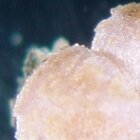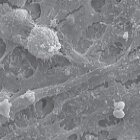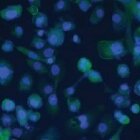Biology
Open access articles in biology. Articles from Bioinformatics and Biology Insights, Cell Biology Insights, Gene Regulation and Systems Biology, Glycobiology Insights, Microbiology Insights, Reproductive Biology Insights.




 Latest news
Latest news
- Newsletter summary (week 37, 2009)
-
- 25/Sep/2009
- Interview with Cancer Informatics editorial board member Dr Grant Izmirlian
-
- 22/Sep/2009
- Call for papers for Analytical Chemistry Insights from Dr Gabor Patonay
-
- 22/Sep/2009
- Sponsor the IBM-OCI Integrative Discovery team in Ride to Conquer Cancer
-
- 15/Sep/2009
- No article processing fees for selected journals
-
- 25/Sep/2009
- Newsletter summary (week 36, 2009)
-
- 15/Sep/2009
- Interview with Healthy Aging and Clinical Care in the Elderly editorial board member Dr Davide Malatesta
-
- 15/Sep/2009
- Interview with Translational Oncogenomics author Dr David Frank
-
- 10/Sep/2009
- Interview with Retrovirology: Research and Treatment author Dr Elcio Leal
-
- 10/Sep/2009
- Interview with Microbiology Insights author Dr Tinatin Doolotkedlieva
-
- 10/Sep/2009
- Call for papers for Drug Target Insights by Dr Monica Milani
-
- 10/Sep/2009
- Call for papers for Clinical Medicine: Urology from Dr Xiangyi Lu
-
- 10/Sep/2009
- Research profile on Gene Regulation and Systems Biology author Dr Noboru Uchide
-
- 09/Sep/2009
- Interview with Biomarker Insights editorial board member Dr Lawrence Cheskin
-
- 07/Sep/2009
- Newsletter summary (week 35, 2009)
-
- 04/Sep/2009
- Research profile of Clinical Medicine: Endocrinology and Diabetes author Dr Hiro Koshiyama
-
- 04/Sep/2009
- Open access articles published in August
-
- 03/Sep/2009
- Call for papers for Clinical Medicine: Circulatory, Respiratory and Pulmonary Medicine from Dr Hussein Foda
-
- 03/Sep/2009
- Interview with Cancer Informatics editorial board member Dr Georgios S. Stamatakos
-
- 03/Sep/2009
- Announcing mobile Libertas Academica website
-
- 02/Sep/2009
- Call for papers for Particle Physics Insights from Dr Hanna Moussa
-
- 02/Sep/2009
- Call for papers for Clinical Medicine: Dermatology from Dr Robert Pearl
-
- 01/Sep/2009
- Interview with Immunotherapy Insights editorial board member Dr Stéphanie McArdle
-
- 01/Sep/2009
- Interview with Cell Communication Insights editorial board member Dr John S Torday
-
- 01/Sep/2009

 Latest articles
Latest articles
- Prospects for Proteomics Directed Genomic and Genetic Analyses in Disease Discoveries
- Pharmacotherapy Options in Cancer Treatment-Induced Bone Loss: Focus on Bisphosphonates
- Current Rational to Prescribe Tigecycline: Critical Analysis of the Evidence and Usage Algorithms by an Argentinean Experts Panel
- Infliximab: A Review of its Use in the Treatment of Crohn’s Disease
- Metformin: A Review of its Use in the Treatment of Type 2 Diabetes
- Autism Etiology: Genes and the Environment
- Left Ventricular Rupture Post Mitral Valve Replacement
- Graphical User Interfaces for Molecular Dynamics—Quo Vadis?
- Pharmacotherapy of Chronic Obstructive Pulmonary Disease: Focus on Arformoterol Tartrate
- A Review of Sildenafil in the Treatment of Pediatric Pulmonary Arterial Hypertension
- Impact of One-Year Methadone Maintenance Treatment in Heroin Users in Jiangsu Province, China
- Bioremediation of Bisphenol A and Benzophenone by Glycosylation with Immobilized Marine Microalga Pavlova sp.
- Metabolic Complications of Bypass Surgery for Morbid Obesity
- Collaboration to Meet a Therapeutic Need: The Development of Nelarabine
- Taxonomy of Bacteria Nodulating Legumes
- Hemangioma of the Thyroid
- Good News from Aliskiren?
- The Influence of Traditional Herbal Medicine (Kampo) on Anti-cyclic Citrullinated Peptide Antibody Levels
- Present and Prospective Pharmacotherapies in Pulmonary Arterial Hypertension
- Tigecycline in the Treatment of Community-Acquired Pneumonia
Most read articles
- Current Status of Monocyte Differentiation-Inducing (MDI) Factors Derived from Human Fetal Membrane Chorion Cells Undergoing Apoptosis after Infl uenza Virus Infection
- Relationship Between the Plasma Concentration of C-Reactive Protein and Severity of Peripheral Arterial Disease
- Intraspecific ITS Variability in the Kingdom Fungi as Expressed in the International Sequence Databases and Its Implications for Molecular Species Identification
- A Simple Derivation of the Distribution of Pairwise Local Protein Sequence Alignment Scores
- Mammoth and Elephant Phylogenetic Relationships: Mammut Americanum, the Missing Outgroup
- DICOM Structured Reporting and Cancer Clinical Trials Results
- Evaluation of Two Outlier-Detection-Based Methods for Detecting Tissue-Selective Genes from Microarray Data
- Systems Biology-Based Identification of Crosstalk between E2F Transcription Factors and the Fanconi Anemia Pathway
- Exploring the Evolutionary History of the Differentially Expressed Genes between Human Populations: Action of Recent Positive Selection
- On the Adaptive Design Rules of Biochemical Networks in Evolution
- Fast Genes and Slow Clades: Comparative Rates of Molecular Evolution in Mammals
- Phylogenetic diversity (PD) and biodiversity conservation: some bioinformatics challenges
- Identification and Quantitation of Asparagine and Citrulline Using High-Performance Liquid Chromatography (HPLC)
- Identification of Conflicting Selective Effects on Highly Expressed Genes
- In Silico Promoter Analysis can Predict Genes of Functional Relevance in Cell Proliferation: Validation in a Colon Cancer Model
(previous 30 days)Site updates
Bioinformatics and Biology Insights
In the past years an increasing number of graphical user interfaces for Molecular Dynamics (MD) were presented and concomitantly, more and more Molecular Dynamics studies were published. With the easier application of MD software packages the field runs the risk however, of being pervaded with unreliable results. Therefore, possible benefits...
Gromita is a fully integrated and efficient graphical user interface (GUI) to the recently updated molecular dynamics suite Gromacs, version 4. Gromita is a cross-platform, perl/tcl-tk based, interactive front end designed to break the command line barrier and introduce a new user-friendly environment to run molecular dynamics simulations through Gromacs....
Analysis of gene expression data provides an objective and efficient technique for sub‑classification of leukemia. The purpose of the present study was to design a committee neural networks based classification systems to subcategorize leukemia gene expression data. In the study, a binary classification system was considered to differentiate acute lymphoblastic...
Cell Biology Insights
A Salt-Threshold Required for Exacerbating Insulin Resistance in Dahl Salt-Sensitive (S) Rats (20/Aug/2008)
The Dahl salt-sensitive (S) rat is a model of genetically determined salt-sensitivity and insulin resistance. In fact, insulin resistance is an inherited genetic trait that precedes and eventually co-exists with salt-sensitive hypertension in Dahl S, but not salt-resistant (R) Dahl rats. Owing to the critical role of salt in accelerating...
Introductory Editorial (Cell Biology Insights) (04/Mar/2008)
Introductory Editorial by Dr Jianping Xu, Department of Biology, McMaster University, Hamilton, Ontario, Canada.
Gene Regulation and Systems Biology
Evaluation of the Role of FGF23 in Mineral Metabolism (03/Aug/2009)
Fibroblast growth factor 23 (FGF23) has recently been identified as a critical regulatory factor in phosphate (P) metabolism. Although the exact molecular mechanism of FGF23 synthesis through sensing the concentration of P is yet to be determined, experimental and clinical data indicate the influential role of FGF23 in P and...
SG2NA is a member of the striatin protein family. In human and mouse, the SG2NA gene encodes two major protein isoforms: SG2NAα and SG2NAβ. The functions of these proteins, except for acting as the regulatory subunits for PP-2A, remain largely unknown. To explore the possible functions of SG2NA in lower...
Application of Petri Nets in Bone Remodeling (06/Jul/2009)
Understanding a mechanism of bone remodeling is a challenging task for both life scientists and model builders, since this highly interactive and nonlinear process can seldom be grasped by simple intuition. A set of ordinary differential equations (ODEs) have been built for simulating bone formation as well as bone resorption....
Glycobiology Insights
Introductory Editorial (Glycobiology Insights) (06/Apr/2009)
Introductory Editorial by Dr Hafiz Ahmed, Assistant Professor, University of Maryland Biotechnology Institute, Baltimore, Maryland, U.S.A.
Journal of Cell Death
The gene for Rhotekin 2 (RTKN2) was originally identified in a promyelocytic cell line resistant to oxysterol-induced apoptosis. It is differentially expressed in freshly isolated CD4+ T-cells compared with other hematopoietic cells and is down-regulated following activation of the T-cell receptor. However, very little is known about the function of...
Pathogenesis of anthrax lethal toxin (LT) is attributed to its ability to cause death of infected cells. New work has demonstrated that increase of mitochondrial F1F0 ATPase activity and subsequent depletion of cellular ATP level are critical early events during LT-induced cell death.
ATP Depletion Via Mitochondrial F1F0 Complex by Lethal Factor is an Early Event in B. Anthracis-Induced Sudden Cell Death (27/Aug/2009)
Bacillus anthracis’ primary virulence factor is a tripartite anthrax toxin consisting of edema factor (EF), lethal factor (LF) and protective antigen (PA). In complex with PA, EF and LF are internalized via receptor-mediated endocytosis. EF is a calmodulin- dependent adenylate cyclase that induces tissue edema. LF is a zinc-metalloprotease that...
Microbiology Insights
Taxonomy of Bacteria Nodulating Legumes (18/Sep/2009)
Over the years, the term “rhizobia” has come to be used for all the bacteria that are capable of nodulation and nitrogen fixation in association with legumes but the taxonomy of rhizobia has changed considerably over the last 30 year. Recently, several non- rhizobial species belonging to alpha and beta subgroup of Proteobacteria have been identified as nitrogen-fixing legume symbionts. Here we provide an overview of the history of the rhizobia and the widespread phylogenetic...
Affinity Association Between Polynucleotide, Glycoprotein, or Sulfated Polysaccharides and Disease-Associated Prion Protein (17/Aug/2009)
Proteinase-K resistant prion protein (PrPres) has the property to aggregate in TSE-injured animal tissues. We have developed a test method to discriminate scrapie-infected and mock-infected hamsters by detecting the PrPres in plasma. It seemed that aggregation of the PrPres with some heterogeneous molecule(s) enabled successful detection by this method. In...
Evaluation of the Hydrophobic Grid Membrane Filter for the Enumeration of Moulds and Yeasts in Naturally-Contaminated Foods (22/Jul/2009)
Over 240 food samples from six food groups (tree nuts, grains and grain products, dried fruits, fresh produce, fruit juice, and dairy products) were tested for levels of fungal contamination using the NEO-GRID hydrophobic grid membrane filter (HGMF) and the FDA official (BAM) method. Results showed that HGMF performed very...
Reproductive Biology Insights
Body Weight and Fertility (02/Sep/2009)
Obesity presents an increasing prevalence in developed countries and impairs human reproduction in both natural and assisted conception cycles. A healthy liveborn is less probable among obese women due to a combination of lower implantation and pregnancy rates, higher preclinical and clinical miscarriage rates and more frequent complications during pregnancy...
Caffeine, Alcohol, and Psychological Stress and In Vitro Fetilization (02/Sep/2009)
There has been an astounding explosion in the number of clinics offering ART techniques- 426 program in the US and 600 in Europe. Despite enormous advances regarding the technical aspects of the IVF procedure, the parents’ contribution has virtually been ignored. What is reassuring for patients is that lifestyle...







